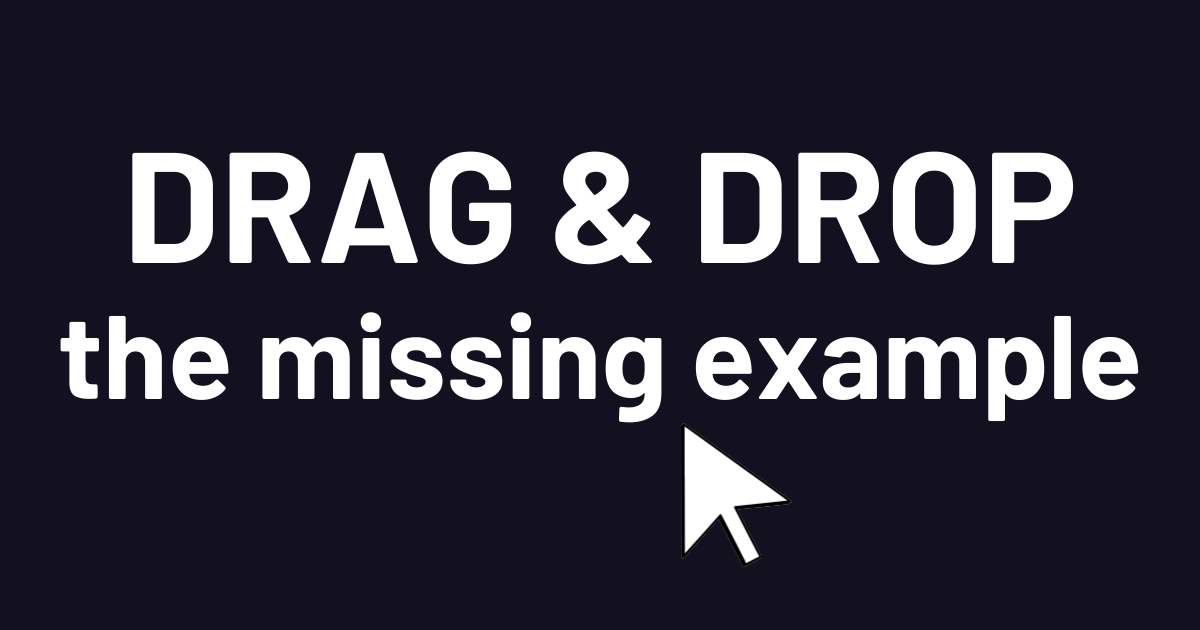TLDR: Learn React drag and drop with the example missing from most tutorials.
React Drag and Drop
Drag and drop can be a very useful feature in your React application.
In a music app, you may want to allow users to reorder songs in a playlist.
In a workout app, you may want to allow users to reorder exercises in a workout plan.
Or in a simple todo app, you may want to allow users to reorder tasks in a list.
In all of these cases, adding drag and drop functionality to your application is a great way to make it more user-friendly.
dndkit
dndkit is a drag and drop library for React, and I'll be using it in this article.
I provided a tutorial for react-beautiful-dnd in the past, but at the time of this article, dndkit is the prevalent drag and drop library for React.
If you are interested, I also have a drag and drop tutorial for Vanilla JS.
Let's get started with dndkit by installing it with npm:
npm i @dnd-kit/core @dnd-kit/sortable @dnd-kit/utilities
The Missing Example
Most drag and drop code examples show data with an id field and other fields like name or description.
[
{
"id": 1,
"artist": "The Beatles",
"title": "Hey Jude",
},
{
"id": 2,
"artist": "Neil Young",
"title": "My My, Hey Hey",
},
{
"id": 3,
"artist": "The Rolling Stones",
"title": "Wild Horses",
}
]
This makes a nice, simple example, but it ignores how it will likely integrate with a full stack application using a database.
The id field is often also the primary key for a table in the database.
If we made changes to our playlist above, it would be better to save the playlist order with an additional field like sequence or order.
[
{
"id": 1,
"artist": "The Beatles",
"title": "Hey Jude",
"sequence": 1,
},
{
"id": 2,
"artist": "Neil Young",
"title": "My My, Hey Hey",
"sequence": 2,
},
{
"id": 3,
"artist": "The Rolling Stones",
"title": "Wild Horses",
"sequence": 3,
}
]
Now, when we make changes to the playlist sequence, we can save it back to our database without impacting a primary key.
With this in mind, let's set up a drag and drop example with dndkit.
List Component Imports
The example List component will receive data that is shaped liked the example data with the sequence field.
export type Item = {
id: number,
artist: string,
title: string,
sequence: number
}
type Props = {
data: Item[]
}
Let's start with the necessary imports:
// List.tsx
import { useState } from 'react'
import {
closestCenter, DragEndEvent, DragOverlay, DragStartEvent, PointerSensor, TouchSensor, useSensor,
useSensors, DndContext
} from '@dnd-kit/core'
import { arrayMove, SortableContext, verticalListSortingStrategy } from '@dnd-kit/sortable'
I'm not going to go into detail describing each import. That would be like republishing the docs for dndkit, but feel free to read the docs and dive deeper on anything you want.
Client-side React vs Next.js
Before I share the rest of the component code, I need to highlight one important difference between client-side React and Next.js.
A traditional React app is all client-side code and can use the DndContext I show imported above.
Next.js will do a server-side render of your component first - even if you use the "use client" directive. This will cause a hydration mismatch warning when you drag and drop because you are moving around DOM elements.
If you're using Next.js, you will want to use a dynamic import instead of importing DndContext directly.
Add this to your code:
import dynamic from 'next/dynamic'
// rest of imports here
const DndContextWithNoSSR = dynamic(() => import('@dnd-kit/core').then(mod => mod.DndContext), { ssr: false })
Now, instead of the DndContext import, you will use DndContextWithNoSSR.
List Component State & Functions
Below is the logic for the List component. It boils down to two state variables and four functions.
For the most part, these examples are basic variations of what you will find in the documentation. However, what I believe is worthy to highlight is how the sequence and id properties interact.
export function List({ data }: Props) {
const [items, setItems] = useState(data)
const [activeItem, setActiveItem] = useState<Item | undefined>(undefined)
// for input methods detection
const sensors = useSensors(useSensor(PointerSensor), useSensor(TouchSensor))
const removeItem = (id: number) => {
const updated = items.filter(item => item.id !== id).map((item, i) => ({ ...item, sequence: i + 1 }))
setItems(updated)
}
// triggered when dragging starts
const handleDragStart = (event: DragStartEvent) => {
const { active } = event
setActiveItem(items?.find(item => item.sequence === active.id))
}
const handleDragEnd = (event: DragEndEvent) => {
const { active, over } = event
if (!over) return
const activeItem = items.find(ex => ex.sequence === active.id)
const overItem = items.find(ex => ex.sequence === over.id)
if (!activeItem || !overItem) {
return
}
const activeIndex = items.findIndex(ex => ex.sequence === active.id)
const overIndex = items.findIndex(ex => ex.sequence === over.id)
if (activeIndex !== overIndex) {
setItems(prev => {
const updatedWorkoutData = arrayMove(prev, activeIndex, overIndex).map((ex, i) => ({ ...ex, sequence: i + 1 }))
return updatedWorkoutData
})
}
setActiveItem(undefined)
}
const handleDragCancel = () => {
setActiveItem(undefined)
}
// rest of component code here
List Component Return Value
Not too leave anything out, here is the return value of the List component.
Note, this example is using the DndContextWithNoSSR import for Next.js. If you are using client-side React, you can use DndContext instead of DndContextWithNoSSR.
return (
<div className="flex flex-col gap-2 w-1/2 mx-auto">
{items?.length ? (
<DndContextWithNoSSR
sensors={sensors}
collisionDetection={closestCenter}
onDragStart={handleDragStart}
onDragEnd={handleDragEnd}
onDragCancel={handleDragCancel}
>
<SortableContext
items={items.map(item => item.sequence)}
strategy={verticalListSortingStrategy}
>
{items.map(item => (
<SortableRow
key={item.id}
item={item}
removeItem={removeItem}
/>
))}
</SortableContext>
<DragOverlay adjustScale style={{ transformOrigin: "0 0 " }}>
{activeItem ? (
<SortableRow
item={activeItem}
removeItem={removeItem}
forceDragging={true}
/>
) : null}
</DragOverlay>
</DndContextWithNoSSR>
) : null}
</div>
)
}
SortableRow Component
You've surely noticed there is a SortableRow component in the example above that I did not show with the other imports.
Let's take a look at it and don't forget to import it in your List component after you create it.
This component doesn't stray far from the typical examples I have seen, but again, I want to highlight where the sequence value comes into play.
import { XIcon } from 'lucide-react'
import { useSortable } from '@dnd-kit/sortable'
import { CSS } from '@dnd-kit/utilities'
import { Button } from './ui/button'
import type { Item } from "./List"
type Props = {
item: Item,
removeItem: (id: number) => void,
forceDragging?: boolean,
}
export function SortableRow({ item, removeItem, forceDragging = false }: Props) {
const {
attributes,
isDragging,
listeners,
setNodeRef,
setActivatorNodeRef,
transform,
transition
} = useSortable({
id: item.sequence,
})
const parentStyles = {
transform: CSS.Transform.toString(transform),
transition: transition || undefined,
opacity: isDragging ? "0.4" : "1",
lineHeight: "4",
}
const draggableStyles = {
cursor: isDragging || forceDragging ? "grabbing" : "grab",
}
return (
<article
className="flex flex-col w-full gap-2 [&:not(:first-child)]:pt-2" ref={setNodeRef}
style={parentStyles}
>
<div className="bg-secondary w-full rounded-md flex items-center gap-2 overflow-hidden">
<div className="bg-ring w-12 h-full flex items-center">
<p className="w-full text-center text-secondary">{item.sequence}</p>
</div>
<div
ref={setActivatorNodeRef}
className="flex-grow p-2"
style={draggableStyles}
{...attributes} {...listeners}
>
<h2 className="text-lg">
{item.title}
</h2>
<p className="text-sm">{item.artist}</p>
</div>
<div className="w-12 h-full flex items-center">
<Button
type="button"
size="icon"
variant="outline"
onClick={() => removeItem(item.id)}
>
<XIcon className="text-red-500" />
</Button>
</div>
</div>
</article>
)
}
Where to Go Next
Admittedly, this article is a bit of a code dump. If you are trying to learn more about each detail of dndkit, I recommend you read the docs as they do hold a lot of information.
My goal in sharing this article was to provide what I could not quickly find - an example of using dndkit where you do not change the id value of your data and instead, work with a separate sequence value.
If you were looking for the same thing, I hope this article has helped you.
Video Tutorial
I created a video tutorial based on this article, too.
Check it out!

